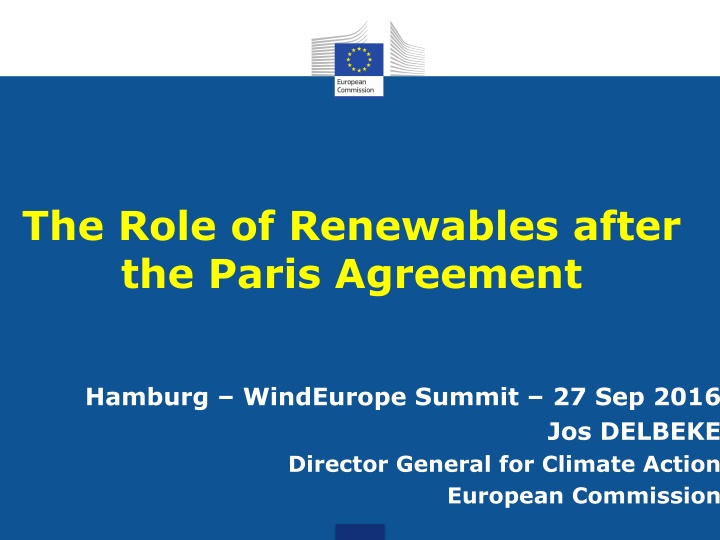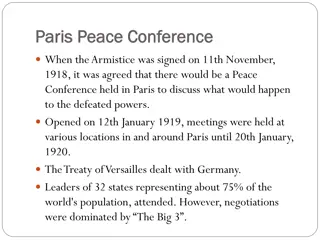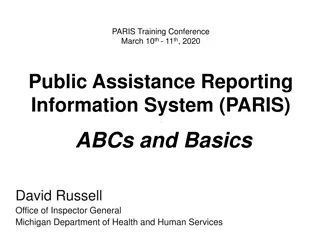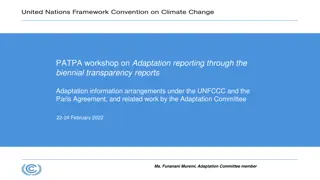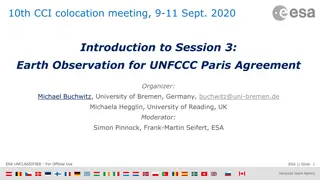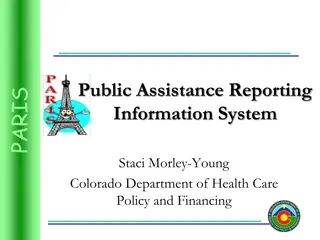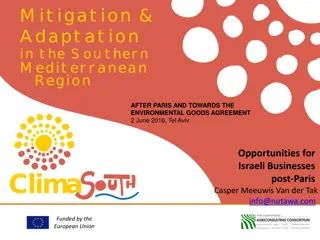Renewables Post Paris: Aims & Actions
Paris Agreement sets challenging targets for global climate action, emphasizing renewables, emissions reduction, and sustainable growth post-2020. The EU's strategies and progress towards decoupling emissions from GDP, targets for GHG reduction, renewable energy integration, and the Emission Trading System are key focus areas underlining global efforts in mitigating climate change post-Paris Agreement.
Download Presentation

Please find below an Image/Link to download the presentation.
The content on the website is provided AS IS for your information and personal use only. It may not be sold, licensed, or shared on other websites without obtaining consent from the author.If you encounter any issues during the download, it is possible that the publisher has removed the file from their server.
You are allowed to download the files provided on this website for personal or commercial use, subject to the condition that they are used lawfully. All files are the property of their respective owners.
The content on the website is provided AS IS for your information and personal use only. It may not be sold, licensed, or shared on other websites without obtaining consent from the author.
E N D
Presentation Transcript
The Role of Renewables after the Paris Agreement Hamburg WindEurope Summit 27 Sep 2016 Jos DELBEKE Director General for Climate Action European Commission
The Paris Agreement Ambitious long-term goals : well-below 2 C pursue 1.5 C global peaking asap climate neutrality in the second half of the century Universal agreement 189 nationally determined contributions (NDCs) Greater emphasis on adaptation Support for poor and vulnerable countries 2
World emissions (GtC02e, total excluding sinks) and percent change in emission intensity per unit of GDP Source: POLES JRC Model 3
Total EU GHG emission trend 6.000 20% reduction compared to 1990 5.000 4.000 -23% in 2014 At least 40% reduction compared to 1990 Mt CO2 equivalent 3.000 2.000 1.000 80% reduction compared to 1990 0 1990 1995 2000 2005 2010 2015 2020 2025 2030 2035 2040 2045 2050 Historic emissions Projections with existing measures (based on MS submissions) 4 Source: EEA, Commission
EU : Decoupling growth from emissions 160 + 46% GDP 140 120 Index 1990=100 100 80 - 23% GHG emissions GDP 60 GHG emissions GHG intensity 40 1996 1990 1991 1992 1993 1994 1995 1997 1998 1999 2000 2001 2002 2003 2004 2005 2006 2007 2008 2009 2010 2011 2012 2013 2014 Source: European Commission based on data compiled by EEA 5
2030 EU Framework for Climate and Energy -20 % Greenhouse Gas Emissions 20% Renewable Energy 20 % Energy Efficiency 10 % Interconnection 2020 - 40 % Greenhouse Gas Emissions 27%* Energy Efficiency 27 % Renewable Energy 15 % Interconnection 2030 * To be reviewed by 2020, having in mind an EU level of 30% 6
EU Emission Trading System (ETS) One EU wide target : -21% in 2020 and -43% in 2030 One single EU carbon price Harmonised infrastructure and operation + delivery of target + cost-effective reductions - weak incentives for alternatives (low prices) 7
Cap & Linear reduction factor (LRF) LRF is an existing concept in ETS Directive LRF provides: Predictability Orderly functioning of carbon market Transparency Investment signal 8
The European Carbon Market Source: adapted from ICE Note: The Front December Price is the price for the ICE futures contract for delivery in the first upcoming December. Since Phase I EUAs could not be used after December 2007, for Dec 2006 and the whole of 2007, the price for the Dec2008 strip was used 9
INDCs : References to carbon pricing Adapted from WRI-CAIT Ref. in INDCs to: Domestic ETS and carbon taxes Planned / possible use of int'al market mechanisms No specific references or no INDC yet 10 Climate Action
Increase in Coverage of GHG by Emission Trading 11 IETA Climate Action
Renewable Energy Directive Differentiated national targets, adding up to 20 % for the EU by 2020 National (wide ranging) support schemes + delivery of target : 16 % in 2014 (8% in 2008) - impact on internal electricity market - Fragmented markets - Overcompensation ? - cost-effectiveness For 2030 : EU-wide target of at least 27 % 12 Climate Action
EU Renewable energy : today 16 % of energy use in the EU (Mtoe) 13 Source: Eurostat Climate Action
Potential impact of INDCs on global cumulative investment in the power sector, 2015 2040 14 IEA WEO2015
Potential impact of INDCs on power generation retirements and additions, 2015-2040 15 IEA WEO2015
Growth in RES electricity generation 2015-2040 16 Source: IEA WEO 2015
Renewables policies contribute to reduce technology costs Solar PV Module Cost ($/W) Onshore Wind Levelised Cost ($/MWh) 100 1,024 1,024 1976 y = 3,582.42x-0.30 R = 0.91 1985 1985 512 512 1985 H1 2015 H2 2015 10 256 256 2003 2008 Thailand 2009 2009 1999 1999 128 128 2025 2025 2014 2014 64 64 1 Current 2015 price Germany Learning rate =19% R = 0.91 Learning rate 24.3% Learning rate 19% US Brazil 32 32 16 16 0.1 1 10 100 1,000 10,000 100,000 1,000,000 100 100 1,000 1,000 10,000 10,000 100,000 100,000 1,000,000 1,000,000 Cumulative capacity (MW) 17 Note: Pricing data has been inflation corrected to 2014. It is assumed the debt ratio of 70%, cost of debt (bps to LIBOR) of 175, cost of equity of 8% Source: Bloomberg New Energy Finance Note: Prices are in real (2015) USD. Current price is $0.61/W Source: Bloomberg New Energy Finance, Maycock
Record low recent awarding prices 18 Source: Enel Green Power, based on IEA Climate Action
EU ETS auction revenues, 2020-2030 EU Member States should use 50% of their ETS auction revenues for climate-related purposes more than 6bn allowances in total to be auctioned Innovation Fund for low-carbon innovation 450 mio allowances Modernization Fund for energy investments in low- income Member States 310 mio allowances 19 Climate Action
European Fund for Strategic Investments (EFSI) Current EFSI (backed by EU guarantee of 16bn) Expected to trigger 315bn of investments New Commission proposal to extend EFSI until 2020: Increased EU guarantee to enable 500bn of investments At least 40% of EFSI financing on infrastructure and innovation will go to projects contributing to climate action 20 Climate Action
Conclusions The Paris Agreement indicates strong political will to implement energy policies that support RES. Renewable energy is fast growing, in EU and worldwide. Emission trading can play double role for support of renewables: Increases competitiveness relative to fossil fuels Provides revenues that can be used to further support innovation and competitiveness of renewables The EU demonstrates an integrated approach for RES through climate and energy policies. But more harmonisation is needed to create common market for RES Robust governance process is critical 21 Climate Action
Thank you! Visit DG Climate Action online: facebook.com/ EUClimateAction twitter.com/ EUClimateAction pinterest.com/ EUClimateAction youtube.com/ EUClimateAction ec.europa.eu/ clima/ Read our book "EU Climate Policy Explained" (published by Routledge, 2015) English, French, Spanish, Chinese versions online : http://ec.europa.eu/clima/citizens/publications/index_en.htm
